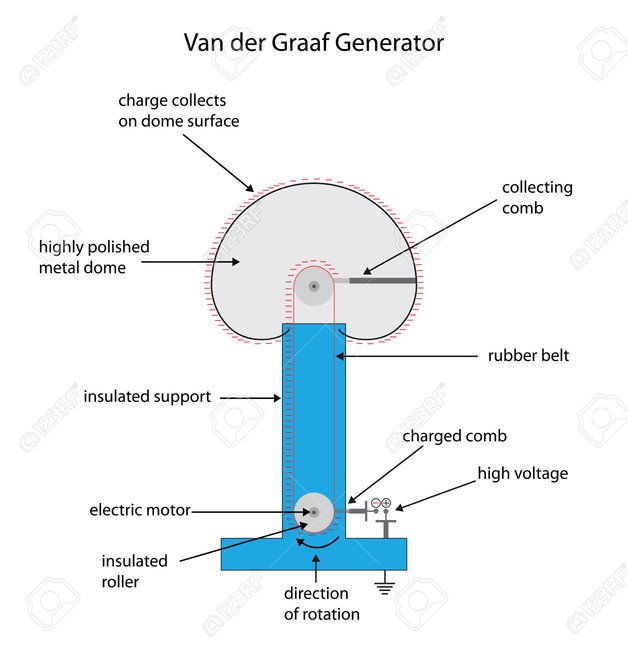Static Discharge ('Shocks') - The Physics
If you've ever received a shock from a metal object like a shopping trolley or doorknob then you've encountered the phenomenon behind lightning, Van de Graaff generators and slide-induced bedhead: the transfer of electrostatic charge.

Some Basics
To understand static charge transfer, and in particular static shocks, we first need to get to grips with some fundamental concepts.
In a conductor, electrons (carriers of negative charge) are free to move.
An insulator, on the other hand, doesn't possess such loose valence electrons (electrons held in an atom's outermost electron orbital), and the movement of charge (current) is restricted.
This distinction is important when our discussion progresses to the movement of charge.
Also key to our explanation is the idea that, while the relative charges of regions may be altered by the movement of charged particles, new net (overall) charge cannot be created; this is the law of conservation of charge.
Analogous to this is the statement: charge may only be created in positive-negative pairs so as to leave the net charge unaffected.
Another basic idea is that opposite charges attract and like charges repel - this is fundamental to electrostatics and we'll come back to it!
Static Shocks
A static shock occurs when a region of net positive or negative charge is able to transfer excess charge (receive or donate electrons, respectively) so as to restore neutral charge equilibrium, a system in which there is no longer a charge difference between materials. A shock may only occur following a local separation of charge, since there must be a charge imbalance to restore to equilibrium.
Sound complicated? We'll break it down.
But first, let's clear up the idea of 'net charges' and regions of charge difference...
Sticky Tape: Regions Of Charge
Consider two pieces of sticky tape stuck to a table.
Removing the two pieces 'strips' the table of some electrons, since the sticky tape is more resistant to losing bound electrons than the table is. Both pieces have obtained a net negative charge, and will repel if brought close together - as we preempted in our preamble.
If both pieces were stuck to one another before contacting the table, things would play out a little differently. Treating the two joined pieces of tape as one, it has again gained a net negative charge. However, tearing the tape pieces apart strips one of its excess electrons, just as the table was stripped of its electrons. Now we are left with one piece of excess negative charge, and one of relative positive charge; the two will attract when brought together.
The Slide Example

Plastic slides act as effective insulators, whereas the human body is comparatively conducive to the movement of free electrons, even with a thin layer of insulating clothing.
When a child uses a slide, their body and clothing rub on the insulating surface.
While free electrons are readily transferred from the child to the slide's surface, the insulator resists the loss of its own tightly-bound electrons.
Although the total charge among the child and slide remains neutral - hence the law of conservation of charge has not been violated - there is now a local imbalance between these two regions of negative and positive charge, much like in our sticky tape example.
The child is now considered 'positively charged' and the slide 'negatively charged'.
How Does This Explain The Hair?
As in our sticky tape analogy, each strand of positively charged hair repels every other, and the mass of each strand is small enough that the repulsive forces are greater than the gravitational force gluing them to the child's head.
We call the charge separation responsible for this phenomenon polarisation, and the mechanism by which it has occurred charging by friction: the act of rubbing has provided the conductor's free electrons with enough kinetic energy to migrate to the insulator (carpets and cloth are also good at setting up static shocks).
Interestingly, this is essentially how a Van de Graaff generator works; a revolving insulating belt and conducting comb within the generator provides the polarisation of charge.

Slides and Van de Graaff generators have the same electrostatic effect.
What Does This Have To Do With Static Shocks?
Once a system's charge is separated, the hard work is done. Now all that's needed is a conductor - a metal gate, for example.
If the positively charged child touches the playground's metal gate shortly after charging, the child-gate system acts to restore the neutral charge equilibrium we discussed earlier.
It does so by allowing its free-to-move, negatively charged electrons to flow into the child until the charges in child and gate are equal (and net-neutrality is restored); in practice, since both bodies are grounded and seek to obtain equilibrium with the Earth, this equilibrium is found at near-neutral charge.
This sudden movement of electrons - or static discharge - constitutes current, and the greater the magnitude of the migrating charge the greater the current. This current, in essence a transfer of energy, is felt by the child as a brief static shock.
Lightning: Static Shocks On Steroids
While the static discharge currents caused by charging from carpets, slides and balloons are very small in magnitude, not all static shocks are harmless.
Lightning, perhaps the most universally feared form of charge transfer, is static discharge following charge separation within clouds.
Although usually accredited to the movement of liquid water and ice particles, the exact mechanism of charge polarisation in clouds isn't totally agreed upon by scientists.
What is certain, however, is the way in which the negatively charged regions of cloud discharge. Once the buildup of charge is sufficient to overcome the atmosphere's insulating nature, the electrons flow via the path of least electrical resistance to restore neutral equilibrium; this path could be to other clouds, or to buildings, trees or humans (any antenna-like grounded object).
But Doorknobs & Shopping Trollies Don't Smite Us...
The reason society will allow children to use playground equipment but not be strapped to the Eiffel Tower during a thunderstorm involves the amount of charge transferred during the respective discharges.
Discharges from small static shocks are very brief since the total amount of migrated charge necessary to restore equilibrium is small. Consequently, very little energy (of the order millijoules, or one millionth of a joule) passes through a shocked body.
In contrast, a lightning bolt - which, remember, may only form once the magnitude of charge separation overcomes the atmosphere's poor electrical conductivity - can transfer a billion joules of energy.
That's enough to power the average light bulb for six months.

If you enjoyed this article and would like more, follow the everyday science blog for your daily dose of science.
References:
www.electrostatics.net
www.wikipedia.org
www.sciencemadesimple.com
www.loc.gov
www.realclearscience.com
www.explainthatstuff.com
www.stevespanglerscience.com
Hank Green's Crash Course
TED-ed
Thank you very much for sharing inspiring content.
Pleased it inspired you - thanks for reading.
Thank you, very nice explanation. I like that you kept it relatively simple.
Thanks - there's a balance to be struck between making science accessible and keeping it accurate!
Great read. I never knew our hair stood up because the electrostatic repulsion becomes greater than the gravitational force forcing it down. The things you know!